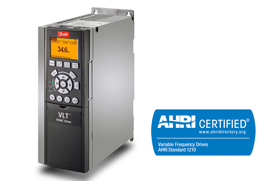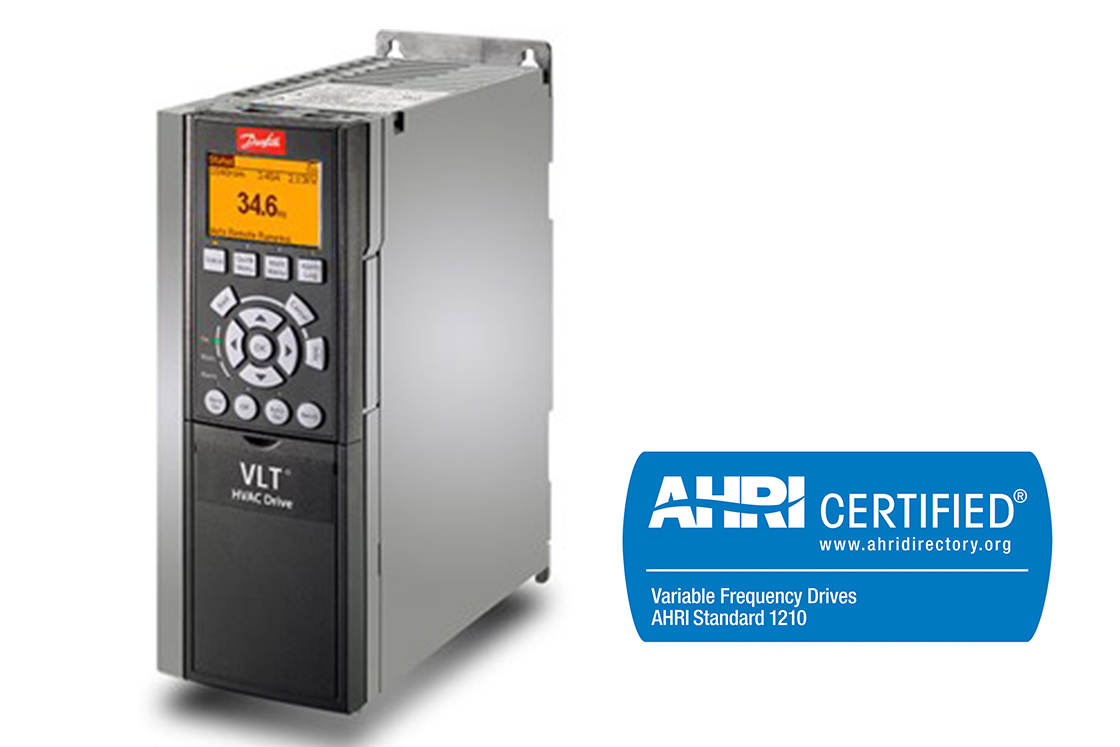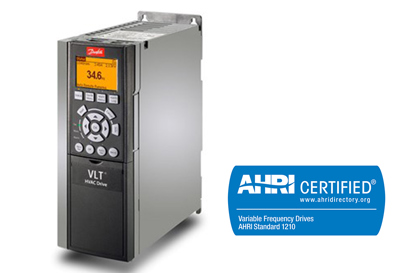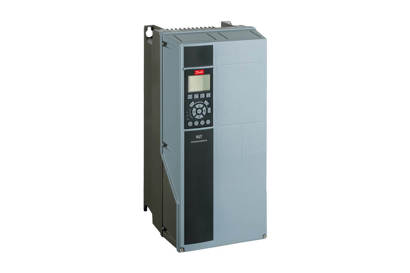Water and sunlight are well understood for being essential to plant growth. But one of the largest nurseries for cut-stem flowers in the central U.S., Len Busch Roses in Minneapolis, Minn., knows there is an additional factor: air. In fact, airflow is so important to the growth of LBR's flowers, the company recently turned to Danfoss to provide a variable frequency drive (VFD) to power the fans used in its largest greenhouse.
“As plants grow, they not only consume water; they also expire water,” explains Rene Vahk, senior technician for Len Busch Roses. “All the water vapor and heat make greenhouse plants very
sensitive to rapid changes in humidity and air temperature. In fact, small differences within the plant microclimate throughout the greenhouse will limit the size of blossoms and stems. Air that is too
humid can also condense on leaves and petals, causing disease problems.”
“That’s why we want temperature, humidity and airflow to stay within a range so our plants are more uniform and more marketable,” according to Tom Nass, grower at Len Busch Roses. “So when I discovered a Danfoss variable frequency drive could improve airflow, I was very interested.”
Growing flowers requires flowing air and water
The family-owned firm of Len Busch Roses has been growing flowers since 1965. Today, their Minneapolis greenhouse complex covers over a half-million square feet — about the area of 100 football fields — where they grow roses, lilies, tulips, gerberas, snapdragons, alstroemeria and more. One of the largest greenhouses, which spans 100 by 250 feet, grows snapdragons.
“This particular greenhouse was ventilated with 13 fixed-speed, 42-inch diameter exhaust fans,” says Vahk. “They were arranged in three banks. A sensor wired into our automation system would turn on one bank of fans, then another and another until the setpoint was reached. But as each bank of fans turned on, it would create a huge difference in airflow. Humidity could fluctuate by as much as 50 percent throughout a single day. On top of that, the fans required a lot of maintenance due to the constant on/off cycling of the equipment. The fan belts would squeak so much, the neighbors in the residential development nearby would complain.”
When Brian Peterson of Schwab, Vollhaber and Lubratt, Inc., (SVL) in Shoreview, Minnesota, heard about these problems, he suggested that Danfoss VLT® Drive technology would solve the airflow and noise problems.
“Rene was already familiar with Danfoss VLT® Drive technology, because I had installed some VLT® AQUA Drives for pumps on their water wells and irrigation systems,” says Peterson. “Being able to vary pump speed to prevent uneven pressure solved a lot of problems related to water flow. When I heard about the noise with the fixed-speed fans, I thought a Danfoss drive would provide smoother startup and variable speed fan control to eliminate the airflow issues.”
VFD provides green solution
“This application is a great example of what a Danfoss VLT® Drive can do if you think outside of the box,” Peterson notes. “In a normal fan-control application, I would specify a Danfoss VLT® HVAC Drive. But in a greenhouse, water gets sprayed all around. So we went with a VLT® AQUA Drive FC202 instead, because it is a washdown-rated IP66/NEMA 4X design.”
A 15-hp Danfoss drive was selected to operate the 13 exhaust fans installed in the sidewall of the snapdragon greenhouse. The fans function like a window box fan. Fresh air is pulled inside the greenhouse as the fans exhaust air outside. Louvers mounted on the fan’s exterior housing prevent air from flowing back inside. Each propeller blade is powered by a V-belt connected to a standard, single-speed 3/4-hp three-phase motor.
“Operating 13 fans with one drive provides a much smoother and more consistent airflow than you can get by cycling banks of fans on and off,” says Peterson. “When more airflow is required, the drive speeds up all the motors together at the same RPM. A minimum speed of 30 Hz is maintained to offset any effect of the wind against the louvers. Then, the RPMs can increase in nearly infinite steps to deliver up to 15,000 cubic feet per minute per fan as needed to meet the temperature and humidity set points.”
The snapdragon greenhouse uses an environmental control system to regulate temperature, lights and humidity. Peterson notes that adding the Danfoss drive did not require an automation system upgrade. Instead, the greenhouse’s analog temperature sensor is wired into the drive, which uses floating point speed control to change motor RPMs.
Less than one-year payback proves value
“Variable speed fan control is making a huge difference,” says Vahk. “The fans speed up or slow down together across a wide RPM range to adjust the ventilation rate more precisely. Proper airflow
creates a more uniform environment. It pulls out excess water vapor and prevents localized hot or cold spots. It also prevents condensation on plants that can occur when the dew point drops to keep pathogens from growing on leaves and petals. The uniform environment ensures consistent growth for all the plants from the center to the perimeter of the greenhouse so all our flowers have higher market value. Plus, we have reduced the number of maintenance hours needed to keep the equipment operational.”
On an irrigation system pump, a Danfoss VLT® AQUA Drive ensured the water line pressure never exceeds the operating design pressure. That stopped previous pressure problems causing water hammer that blew out a four-inch pipe.
The VFDs also proved their value by providing greater energy savings.
For several well pumps, the drives cut kilowatt consumption at critical periods to reduce utility demand charges.
“For the fan application, however, saving energy was not the main issue,” says Peterson. “The most important goal was to create a quality environment. Nonetheless, it’s good to know that improved energy efficiency — and a rebate from the utility — made the payback period for the fan drives very attractive for Len Busch Roses.”
Peterson used free Danfoss VLT® Energy Box software to calculate the return on investment. “This tool gives an accurate calculation based on the greenhouse’s trend log based on the number of fans that were cycled on. I entered in the kilowatt along with the initial cost, installation cost, and the utility rebate to determine the payback.”
The utility, Xcel Energy, offers cash rebates to customers installing variable frequency drives; for Len Busch Roses’ application, the rebate amounted to $2,000. After the rebate was plugged in along with a 22 percent reduction in energy costs, the tool calculated a simple payback time of just eight months.
The Energy Box software also calculated a carbon footprint savings of 6.06 tons of CO2 per year.
Vahk is not only happy to be creating an environment inside the greenhouse than enhances the quality of plant growth, but also to be reducing Len Busch Roses’ footprint on the environment outside. “This was a successful experiment,” Vahk says “We’ve proven that a Danfoss VLT® Drive improves airflow in our snapdragon greenhouse. In the future, we’re definitely interested in applying drives in our other greenhouses. You could say the idea of using Danfoss VLT® Drives for greenhouse exhaust fan control just kept growing on us.
Get more information
-
if (isSmallPicture) {


 VLT® HVAC Drive FC 102
VLT® HVAC Drive FC 102This tough and savvy FC102 drive enhances pump and fan applications in building management systems, and runs outdoors in most climates.
-
if (isSmallPicture) {


 VLT® AQUA Drive FC 202
VLT® AQUA Drive FC 202Maximum energy efficiency for both water /wastewater and Industrial pump/fan applications






